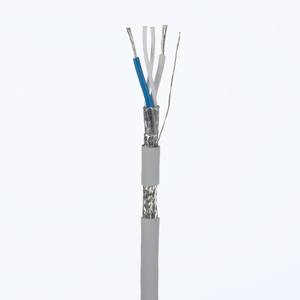

|
Edward Lowton
Editor |


|
| Home> | Plant, Process & Control | >Cables & Connectors | >Single-Pair Ethernet enables reliable IoT infrastructure |
Single-Pair Ethernet enables reliable IoT infrastructure
16 March 2022
Single-Pair Ethernet allows building automation systems and legacy industrial networks to migrate to single Ethernet network technology whilst delivering power and data to and from edge devices, says Stuart McKay

INCREASING DEMANDS on automation infrastructure interoperability means that Single-Pair Ethernet (SPE) is the enabling platform that allows the migration from various legacy networks to one universal physical layer. Now not only smart buildings but also, Industry 4.0 is a step closer to being delivered through a single technology from the edge sensor, plant floor to the corporate desktop.
SPE expands the resource of the Internet of Things (IoT) providing the accelerator for organisations to migrate to Ethernet based operational technology (OT), offering common communications protocols compatible with the information technology (IT) network. This expansion encompasses end-to-end solutions including, switches, valves, cables, and sensors.
Ethernet has also gained share in the Industrial market and is available in a variety of forms including PROFINET, EtherNet/IP and EtherCAT and together with complementary IP-based protocols it is now the dominant data communications platform.
The capabilities of SPE increases the opportunity for an all-Ethernet networking solution, while advances are making the network easier for organisations to implement and manage. The single protocol network will provide for data transparency and increase security.
The initial single-pair IEEE standard 802.3cg-2019, was announced in early 2020, and device chips were launched to support all SPE applications in process automation, industrial automation and building automation within that timeframe.
The reduced number of pairs used for communication, allows for a reduction in cable and connector size, while the technology delivers both power and data to edge devices within a single connection. The IP20 SPE Connector (see Image 1) is a small format module with half the footprint of a RJ45 port, and it features positive latch engagement for secure connection. Integrated power and data eliminate the need for local batteries or power supplies, and saves on transformers and circuit protection, while reduces installation time and simplifying maintenance.
Compared with terminating 4-pair cable to TIA-568A/B standards, field terminating one-pair cable with the LC-style connector is fast and simple. Using common tools, an electrician can perform an SPE termination in half the time taken for a 4-pair termination. It also utilises 18 AWG cable offering lighter, smaller cables. The SPE connector termination will be less prone to error, minimising any rework. Given the decreased weight and size, more cable runs can be pulled together, simplifying implementation.
The importance of data and power over SPE to remote devices cannot be overstated. The IEEE 802.3bu standard provides for remote DC power over the SPE connection, called Power over Data Line, or PoDL. PoDL is akin to the Power-over-Ethernet (PoE) technology for standard Ethernet, which is transforming smart building electrical and data communications infrastructure.
Ethernet networks are faster, offering enhanced techniques like Time Sensitive Networking (TSN) and Software Defined Networking (SDN). And while Four-Pair Ethernet is already well established supporting higher levels in industrial networks, it is not cost-effective for many lower value edge devices.
SPE provides increased bandwidth allowing higher data rates at the edge, with up to 10 Mbps transmission speeds up to 1,000 metre distance. Consider that against legacy protocols based on RS-485, where the link speed is only 31.2kbps for the same 1,000 metres. That is 300 times faster!
SPE’s convenience, cost and relative functionality provide low-cost access for either migration or incremental deployment of SPE within an industrial environment. The technology cost aligns with extending data capture capabilities out to multiple edge devices, where previous access was cost prohibitive.
Expansion of IoT is dependent on cost effective technology coupled with inexpensive sensors to drive scale. High volume automation products are likely to change first, while specialised legacy protocol devices will take longer to replace. Once organisations understand the market advantage they can gain from SPE the implementation of associated devices will increase dramatically, which in turn will reduce complexity of the network as it converges on Ethernet.
Single pair Ethernet is a transformative technology for manufacturers and building and plant facilities. For the manufacturing space and other market segments such as rail transportation and building automation will also begin to adopt SPE networks in the ensuing years.
Stuart McKay is business development manager, Panduit EMEA
For more information:
www.panduit.com
Tel: 020 8601 7219
- SmartZone Intelligent UPS provides efficient and reliable power
- Automatic labelling system
- Panduit launches new generation FlexFusion ITE cabinets
- Cabling infrastructure helps reduce downtime
- Panduit announces new CEO
- Handle on data centre security
- Panduit joins ETIM International
- Absence of voltage tester
- Cable tie hand tool
- We Connect: The Journey of Innovation - 16th June 2021
- Close collaboration key to complex cable installation
- Contact inserts added to connector range
- Specialist distributor award
- Universal cable entry system
- Flexible driver connection for long travel lengths
- 'Multi-pole combination connector for power and signals
- Connectors for harsh environments
- Spring pressure speeds installation
- Connectors: 100% tested
- Cable trails and tags


















